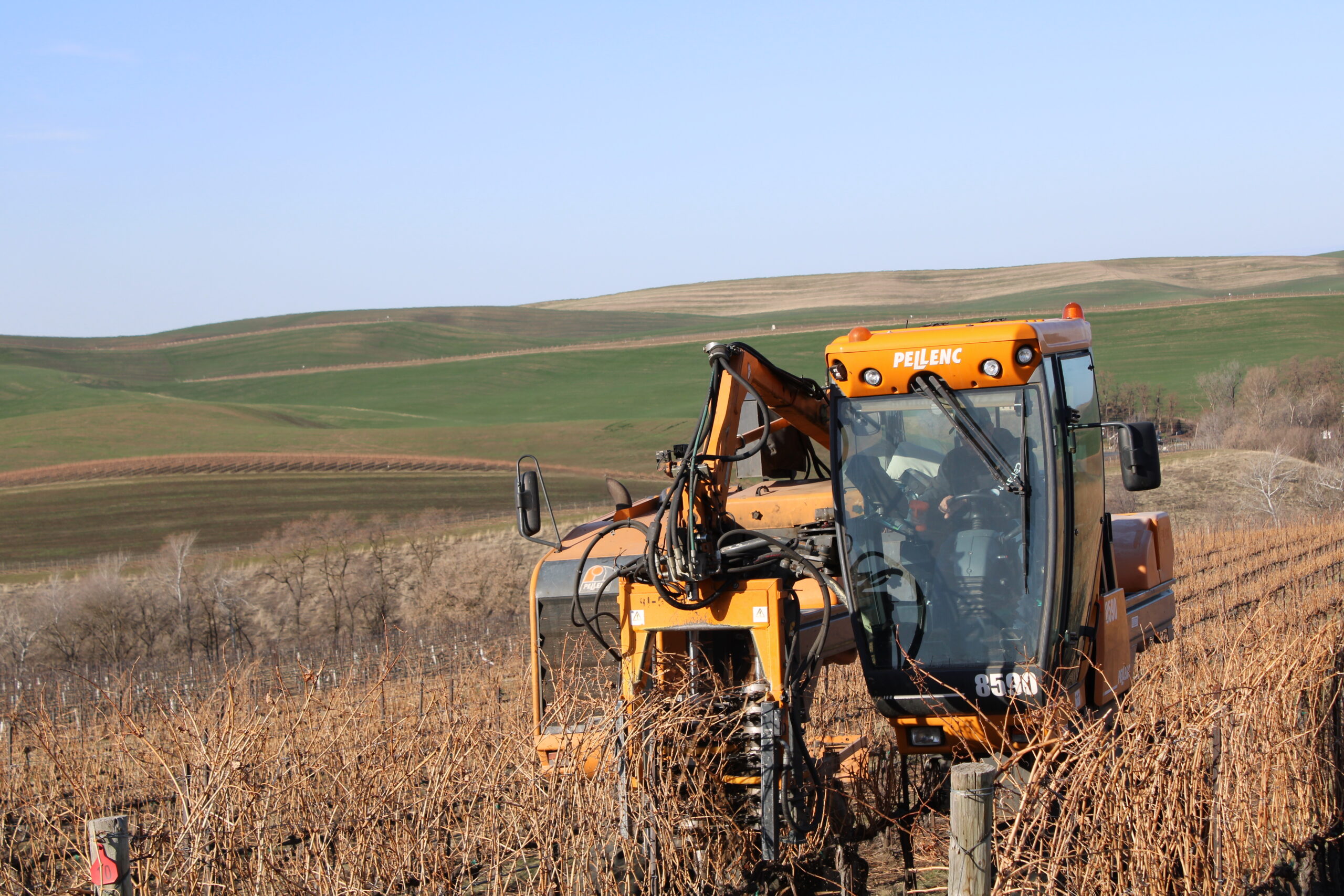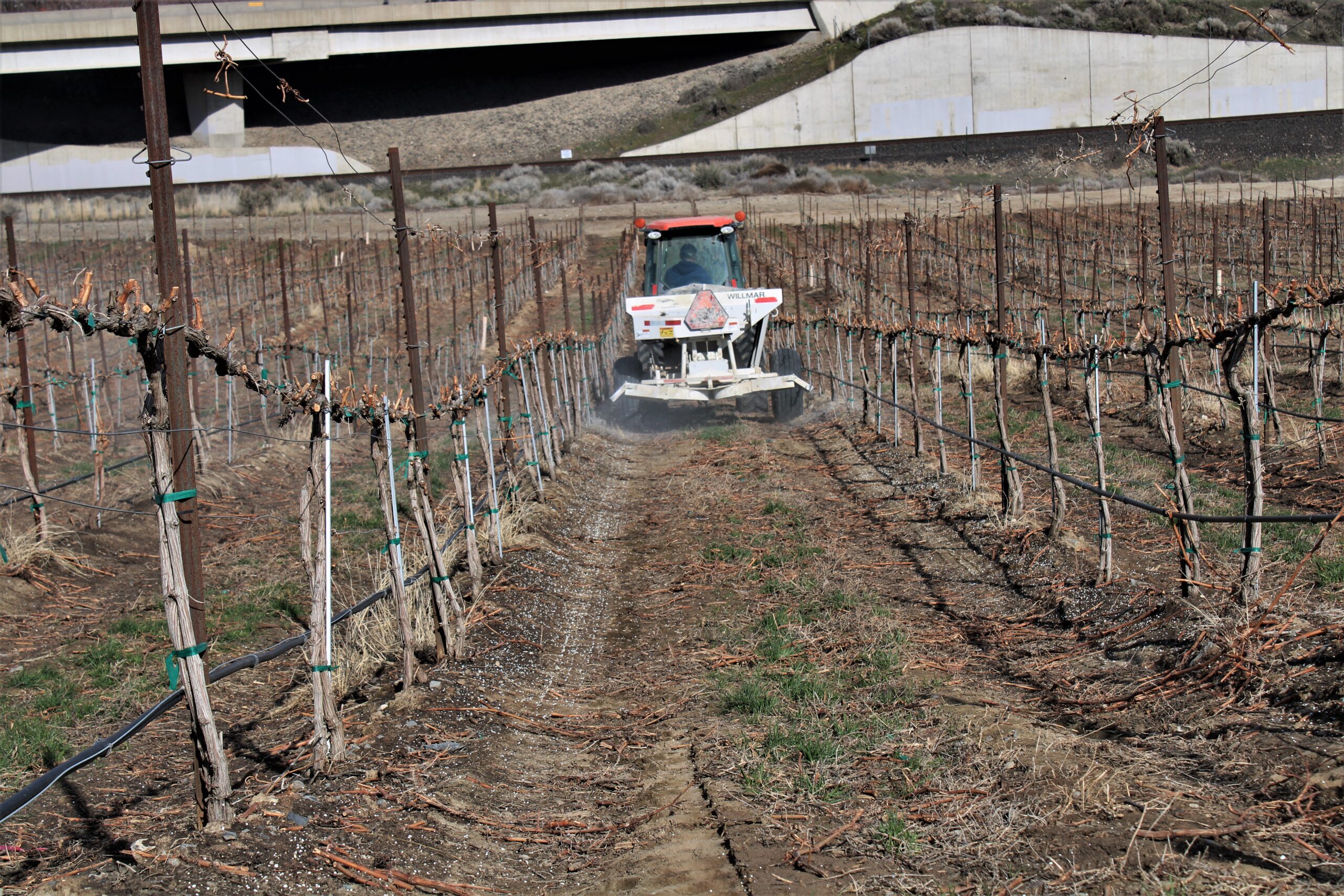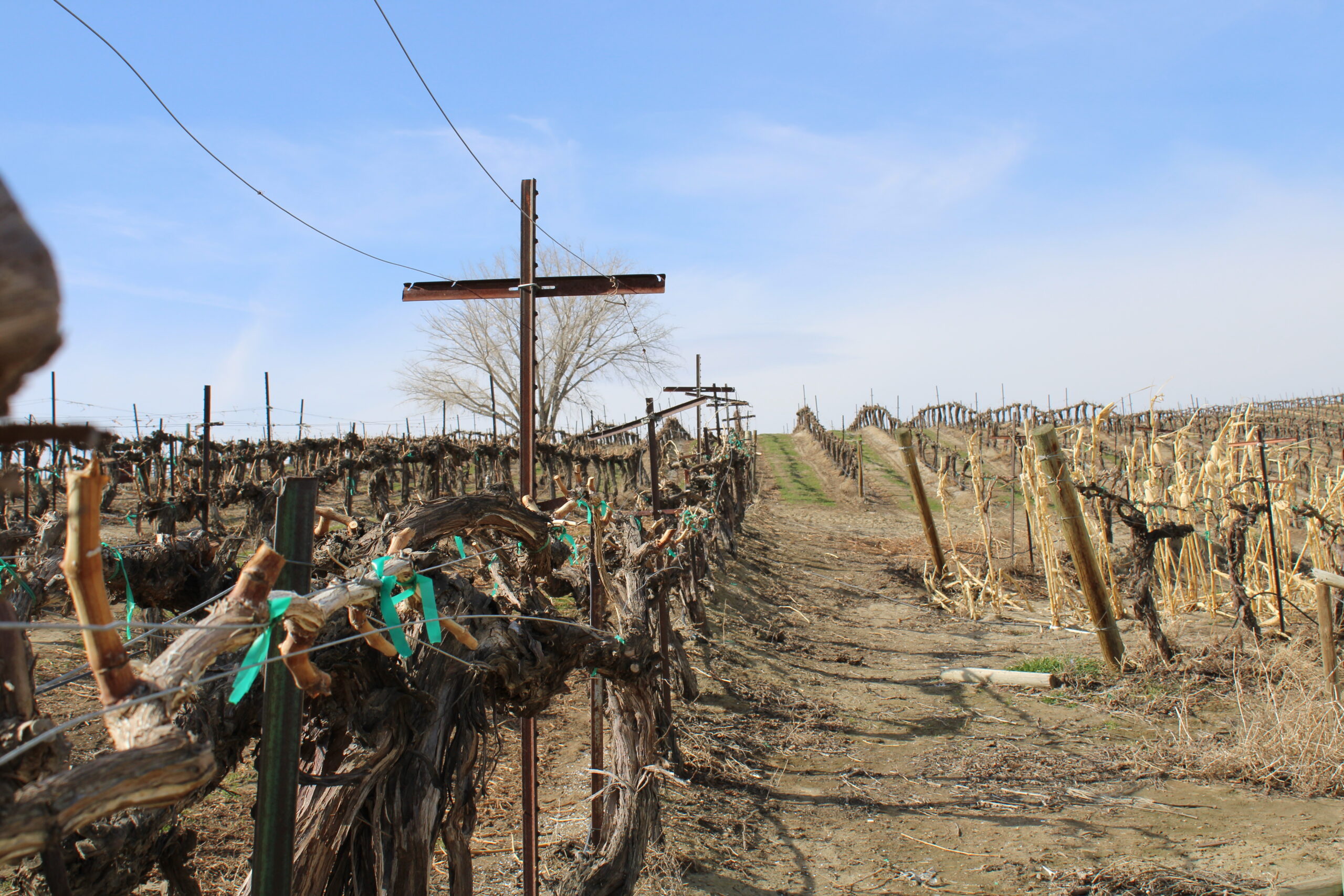Enjoy the first story from Brittany Komm, Senior Viticulturist for Precept Wine.
“We never really stop. We just slow down a little bit.”
Let me first start off by saying how excited I am to be one if the first ambassadors for this Breaking Ground program and platform. I am so very excited to finally have a place where myself, fellow wine grape growers/farmers, and even co-workers and friends can share our stories with you about what it takes to grow that perfect grape. I hope our joy and passion comes through in every story we can share with you.

Man oh man, I am so excited to write this first story that I am literally shaking as I hit the keys and smiling from ear to ear so hard my cheeks hurt. I am trying to decide where I should start (because there is just so much to write about), and I think the most logical point would be to start from January and what we have been up to both in the vineyards and in the office.
Most farmers—and not just wine grape growers—started off this year running wind machines, lighting smudge pots, praying or doing whatever it is they do when Mother Nature decides to throw us all some incredibly cold temperatures. Not many of us got a lot of sleep that night (sadly not because of New Year’s festivities) because we were all too busy worrying about the livelihood of our plants and the future crop that they were holding. We recorded low temps of anywhere from 0.1 F to 10.4 F at three of our estate vineyards (caveat: these weather stations were not situated at the lowest point within the vineyards). Lucky for us and many other growers, we are seeing very minimal bud damage.
It has been an incredibly mild winter for us, which we are loving and hating. We are loving it as we haven’t had many weather delays (until recently) that have kept us from getting out into the vineyards and performing our usual winter tasks. On the flip side of that, we are not liking this because we need the moisture. We need the snowpack in the hills to help sustain us throughout the summer. So, you can see why we are both sides of the table with this issue. This is a topic we worry about every winter as we head into spring if we haven’t had a lot of snow or rain. Mother Nature did decide to give us some rain towards the end of February and into March.

Our Yakima Valley vineyards received a decent amount of rainfall while my Walla Walla Valley vineyard has received a bit more than those vineyards. We have a weather station at our Canoe Ridge Vineyard located in the Horse Heaven Hills and it has logged 1.23 inches of rain since January 1st, our Skyfall Vineyard in the Yakima Valley (Benton City) has logged 1.74 inches and my Waterbrook and Browne Family Estate Vineyards in the Walla Walla Valley have recorded a hefty 3.46 total inches of rain! Now for these two estate vineyards, when it rains, it really puts a damper on all vineyard work. These beautiful estate vineyards are located in the Spring Valley District of Walla Walla and the soils out there are rich in organic matter. Therefore, when it rains, the ground gets really slick out there and since we are planted on former rolling hills of wheat this can spell disaster. So, unfortunately in Walla Walla, we are running a little behind schedule as of now, thanks to our weather delays, but we are okay with it because we know we needed that rain!
Enough about all this weather talk! Our typical winter activities in the vineyard include: ripping out old vineyard blocks, pre-pruning, pruning, composting, applying dry fertilizer, trellis and vineyard maintenance, equipment repair and maintenance. Then for managers such as myself, my winter activities typically consist of catching up on the mile-high stacks of paperwork that have accumulated on my desks since June; attending educational seminars to freshen up my knowledge and learn about new advancements in technology and research that are going on within our everchanging industry; analyzing yield estimates and harvest reports from the prior vintage; designing pruning recommendations for our amazing crews to follow; meeting with winemakers to see how the fruit is progressing; working with the crews while they are out pruning (yes, I love to prune; it is a great stress reliever); working on plans for any new vineyard re-plants that may be coming up; and in general, just prepping everything for the upcoming vintage. We never really stop; we just slow down a little bit.

In 2015, I convinced my former boss to invest in a pre-pruner to make it easier on our crews to prune. I had done some pruning while I was in graduate school and let me tell you what, there was no need to work your arms and shoulders at the gym after that. We also discussed how this would speed our crews up and instead of paying hourly for pruning, we could pay by the piece. It was one of the best purchases he ever made, he said. The morale of the crew went up, and the efficiency went up as well! We have one crew that takes care of our three Yakima Valley Vineyards that totals almost 700 acres. They have roughly 4 months to get through all this acreage. We have a separate crew for our Horse Heaven Hills and Walla Walla Valley properties. If we have no weather delays for the season, we can typically get this all done no problems. However, with the current labor shortages and include weather delays into that we can get behind.
As I wrap this up, we are starting to see sap-flow across all of our estate vineyards (tracking a few days ahead of 2021). You can hear this term referred to as bleeding or crying as well, and if you listen hard enough when out in the vineyard, you can actually hear these little water droplets hit the ground. It truly is a magical sound. There are many old stories as to where these names came from, but we can save that for a later discussion. We all love to see this from the crews to the managers all the way up to the accountant. It means that the vines are starting to come out of dormancy and positive pressure has been re-established within the vines. This also means our soil temperatures are starting to come up as well. This is a sure indicator that spring is on the way and the days of cool temperatures will soon be coming to an end.
Until next time!
Brittany
Permítanme comenzar por decir lo emocionado que estoy de ser una de los primeros embajadores de este Breaking Ground programa y plataforma.
Estoy muy emocionada de tener finalmente un lugar donde yo, mis compañeros de vino viticultores/agricultores, e incluso compañeros de trabajo y amigos puedan compartir nuestras historias con todos sobre lo que se necesita para cultivar una uva perfecta. Espero que nuestra alegría y pasión se manifiesten en cada historia que podamos compartir contigo. Hombre! Estoy tan emocionada de escribir esta primera historia que literalmente estoy temblando cuando presiono las teclas y sonriendo de oreja a oreja con tanta fuerza que me dolían las mejillas. Estoy tratando de decidir por dónde debo empezar (porque hay mucho que escribir), y creo que el punto más lógico sería comenzar a partir de Enero y lo que hemos estado haciendo tanto en los viñedos como en la oficina.
La mayoría de los agricultores, y no solo los productores de uva de vino. Comenzaron este año con máquinas de viento, iluminación, manchar ollas, rezar o hacer lo que sea que hacen cuando la madre naturaleza decide arrojarse a todos. Algunas temperaturas increíblemente frías. No muchos de nosotros dormimos mucho esa noche (lamentablemente no debido a las nuevas festividades del año) porque estábamos demasiado ocupados preocupándose por el sustento de nuestras plantas y la cosecha futura que tenían. Registramos temperaturas bajas de entre 0,1 F y 10,4 F en tres de los viñedos de nuestra finca. (Advertencia: estas estaciones meteorológicas no estaban situadas en el punto más bajo dentro del viñedos).
Por suerte para nosotros y para muchos otros cultivadores, estamos viendo daños mínimos en los cogollos. Ha sido un invierno increíblemente suave para nosotros, que amamos y odiamos. Nos encanta como nosotros no hemos tenido muchos retrasos climáticos (hasta hace poco) que nos impidieron salir a los viñedos y realizar nuestras tareas habituales de invierno. Por otro lado, no nos gusta eso porque necesitamos la humedad Necesitamos la capa de nieve en las colinas para ayudarnos a mantenernos durante todo el verano. Así que puedes ver por qué estamos en ambos lados de la mesa con este tema. Este es un tema que nos preocupa todos los inviernos cuando se acerca la primavera si no hemos tenido mucha nieve o lluvia. La madre naturaleza decidió darnos un poco de lluvia hacia finales de febrero y principios de marzo.
Nuestros viñedos del Valle de Yakima recibieron una buena cantidad de lluvia mientras que mi viñedo del Valle de Walla Walla ha recibido un poco más que esos viñedos. Tenemos una estación meteorológica en nuestro viñedo Canoe Ridge. Ubicado en Horse Heaven Hills y ha registrado 1.23 pulgadas de lluvia desde el 1 de enero, nuestro Skyfall Viñedo en el Valle de Yakima (Benton City) ha registrado 1.74 pulgadas y mi Waterbrook y Browne ¡Family Estate Vineyards en el valle de Walla Walla ha registrado un total de 3.46 pulgadas de lluvia! Ahora
para estos dos viñedos cuando llueve, realmente estropea todo el trabajo del viñedo. Los hermosos viñedos se encuentran en el distrito de Spring Valley de Walla Walla y los suelos de allí son ricos en materia orgánica. Por lo tanto, cuando llueve, el suelo se vuelve muy resbaladizo y como se plantan en antiguas colinas ondulantes de trigo, esto puede significar un desastre. Entonces, desafortunadamente en Walla Walla, nosotros están un poco retrasados a partir de ahora, gracias a nuestros retrasos climáticos, pero estamos de acuerdo con eso porque sabemos que necesitábamos esa lluvia!
¡Basta de toda esta charla sobre el clima! Nuestras actividades típicas de invierno en el viñedo incluyen: arrancar viejas bloques de viña, prepoda, poda, compostaje, aplicación de abono seco, espaldera y viña, mantenimiento, reparación y mantenimiento de equipos. Luego para gerentes como yo, mi invierno actividades típicamente consisten en ponerse al día con las pilas de documentos de una milla de altura que se han acumulado en mis escritorios desde junio; asistiendo a seminarios educativos para refrescar mis conocimientos y aprender sobre nuevos los avances en tecnología e investigación que están ocurriendo dentro de nuestra industria en constante cambio; analizando estimaciones de rendimiento e informes de cosecha de la cosecha anterior; diseñar recomendaciones de poda para nuestros increíbles tripulaciones a las que seguir; reunión con enólogos para ver cómo va la fruta; trabajando con las cuadrillas mientras están podando (sí, me encanta podar; es un gran calmante para el estrés); trabajando en planes para cualquier plantación de nuevos viñedos que pueda estar surgiendo; y en general, simplemente preparando todo para la próxima cosecha. Realmente nunca nos detenemos; simplemente disminuimos la velocidad un poco.
En 2015, convencí a mi antiguo jefe para que invirtiera en una prepodadora para facilitar la poda de nuestros equipos. Había hecho algo de poda mientras estaba en la escuela de posgrado y déjame decirte algo, no había necesidad de trabajar nuestros brazos y hombros en el gimnasio después de eso. También discutimos cómo esto aceleraría a nuestros equipos y en lugar de pagar por hora la poda, podríamos pagar por pieza. fue una de las mejores compras que él alguna vez hizo, dijo. ¡La moral de la tripulación subió y la eficiencia también subió! Tenemos un equipo que se ocupa de nuestros tres viñedos del Valle de Yakima que suman casi 700 acres. Ellos tienen aproximadamente 4 meses para recorrer toda esta superficie. Tenemos un equipo separado para nuestro Horse Heaven Hills y las propiedades de Walla Walla Valley. Si no tenemos retrasos por el clima durante la temporada, normalmente podemos obtener este todo hecho sin problemas. Sin embargo, con la actual escasez de mano de obra e incluir retrasos climáticos en ese momento, podemos quedarnos atrás. Mientras termino con esto, estamos empezando a ver un flujo de savia en todos los viñedos de nuestra propiedad (seguimiento de algunos días antes de 2021).
También puede escuchar este término referido como sangrado o llanto, y si escucha con atención suficiente cuando estás en el viñedo, puedes escuchar cómo estas pequeñas gotas de agua golpean el suelo. Eso verdaderamente es un sonido mágico. Hay muchas historias antiguas sobre el origen de estos nombres, pero podemos guárdelo para una discusión posterior. A todos nos encanta ver esto, desde los equipos hasta los gerentes y hasta el contador. Significa que las vides están empezando a salir de la latencia y la presión positiva ha sido restablecido dentro de las vides. Esto también significa que la temperatura de nuestro suelo está empezando a subir como bien. Este es un indicador seguro de que la primavera está en camino y los días de temperaturas frescas pronto terminarán.
Llegando a su fin.
¡Hasta la proxima!
Brittany Komm


Join the Conversation